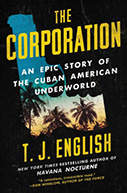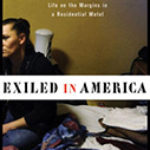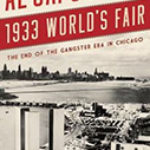The Corporation: An Epic Story Of The Cuban American Underworld

Author: T.J. English
Publisher: New York: William Morrow, 2018. 592p.
Reviewer: Frederick T. Martens | January 2019
There are few contemporary journalists who possess the intellectual heft to actually make sense of the conflating environmental variables that characterize the underground economy. Employing what are fundamental ethnographic research skills, T.J. English’s The Corporation raises the bar for those who wish to understand the Darwinian forces that often characterize the illicit marketplace. Not shy meeting with gangsters, their victims, and members of law enforcement who devote their careers to investigating organized crime, English “gets it,” even if his penchant for journalistic flair exaggerates the relative importance of bolita —a Cuban version of the traditional “numbers” rackets controlled to a large extent by the Cosa Nostra — in the larger universe of what is commonly referred to as organized crime.
Having been intimately involved in the investigation of organized crime in Hudson County, New Jersey during the 1970’s and 1980’s, it is apparent to me that English captures the intricate political and mob-connections of Jose’ Miguel Battle, the so-called El Padrino of the “Cuban Mafia.” With the politically-partnered Joseph “Newsboy” Moriarty having exclusive control over the numbers rackets in Jersey City and Bonnano capo Joseph “Bayonne Joe” Zicarelli being Cosa Nostra’s representative in the remainder of Hudson County, there was always a question as to how Battle and his organization could operate without antagonizing the political power-brokers and Cosa Nostra that ruled Hudson County. English fills in the blanks—or at least provides an interesting story that seems to suggest that the Trafficante, Genovese, DeCalvalcante, and Lucchese Cosa Nostra families arrived at a mutually-beneficial relationship. Whether or not English “got this right” is a matter of debate among others who have pursued this line of inquiry.
For example, the New Jersey State Commission of Investigation contends that there was “no interference from La Cosa Nostra or traditional organized crime, as the two [Battle and Cosa Nostra] honor [ed] each other’s boundaries.” The Commission never explained, at least publicly, how this arrangement came about nor did they specifically attribute it to the brokering skills of Trafficante or others—mobsters, police or politicians (N.J. S.C.I., 1988).
George Manning (2000), a former IRS investigator and forensic accountant, contends that Battle had made an arrangement with Cosa Nostra enlisting the assistance of Joseph Zicarelli and James Napoli, both soldiers in the Genovese Family. Notably, Zicarelli was a capo in the Bonnano Family, which English curiously never discusses, despite Zicarelli’s pervasive influence in Hudson County. Napoli, if he played a role in Hudson County, was certainly much less regarded in Hudson County than Manning seems to imply.
Scott Deitch, the ultimate authority on Trafficante, also never addressed the relationship between Trafficante and Battle in his well-researched book, The Silent Don (2009), which English contends is “essential reading for any organized crime buff.” Moreover, Trafficante’s lawyer, Frank Ragano made no mention of Battle in his memoir (1994). And Ragano’s co-author and New York organized crime expert Selwyn Raab never uncovered an alliance between Battle and the Cosa Nostra in his encyclopedic treatment of the Five Families (Raab, 2014).
Regardless of these conflicting explanations, here English relentlessly searches the written record, relying upon both the courtroom testimony of Vincent Cafaro, a capo in the Genovese Cosa Nostra Family, as well as an interview of Cafaro conducted by Miami detective David Shanks. To his credit, English has provided the reader specifically sourced citations attributed to Cafaro and Shanks. These documents certainly provide compelling non-impeachable evidence, assuming their veracity was critically vetted, evaluated and challenged.
Understanding the corrupt milieu in which Battle operated was essentially encapsulated by the former Governor of New Jersey, Brendan Byrne. Referring to the political corruption that was Hudson County’s signature brand, he would often quip that his last will and testament would reflect his desire to be buried in Hudson County, New Jersey. Why? So that he could remain in politics long after he passed away! The deceased had a habit of voting in elections in Hudson County —or at least their names appeared on the voting rolls and they somehow “voted” on election day.
It was not by chance that Jose’ Miguel Battle chose Union City and Hudson County, New Jersey—the second largest Cuban-American population outside of Miami— to establish his bolita operation.
With the imprimatur of Santo Trafficante, the bolita czar of Tampa, Florida, arrangements were made with the late Cosa Nostra bosses, Simone DeCalvalcante, Anthony Salerno of the Genovese Crime Family, and the Lucchese Family, to establish Battle’s headquarters in Union City. Noticeably absent in this discussion is any mention of the Bonnano Family, which exerted the lion’s share of control of the rackets in Hudson County.
Operating in a city with a sordid history of police and political corruption, Battle met with the renowned bookmaker Peter Kelly “… the last remaining Kelly with ties to the old structure of gambling bosses making payoffs to people in the police and political precincts so that their operations would not be busted.” Kelly “greased” the political gears and opened the doors to those who were eager to welcome this patriotic newcomer—an avowed enemy of the Castro regime. Ultimately however, this corrupt relationship could not forestall the Federal government from investigating Battle and his political and police protection racket, resulting in the arrest and conviction of Union City’s mayor and deputy police chief, among a host of others.
Equally interesting is the role of Cosa Nostra and the CIA in thwarting leftist and Communist takeovers of Latin and South American countries. As English claims, “[e]ven as the mobsters were plotting with the CIA to kill Castro, they were being arrested tried and convicted at an alarming rate”. This English contends, infuriated Trafficante and Cosa Nostra boss Carlos Marcello of New Orleans.
Relying upon the recanted testimony of Jose’ Aleman, an exiled activist in the Cuban community, English subtly implies that the assassination of President John F. Kennedy was at the behest of, plotting by, or actually ordered by Trafficante and Marcello. “Don’t worry about him [Kennedy]. He’s going to be hit,” Aleman is alleged to have been told by Trafficante. English is, however, loathe to completely support this conspiracy idea. Hedging his bets, he concludes, “[i]n the hornet’s nest of co-conspirators, alliances were formed, paths crossed, and assumptions made that led to a tantalizing classification: guilt by association. These names and alliances may or may not hold the key to understanding the killing of President Kennedy. Over time, they have come to comprise a historical sinkhole of personages that has spread a patina of suspicion over many, including, at least peripherally Jose’ Miguel Battle Sr.”
Clearly, Battle’s relationship with Trafficante was in many ways central to his success in New York/New Jersey, according to English. “Battle revered Trafficante…He watched the Tampa Mob boss…glide through the 1950’s Havana like royalty. In the Cuban realm, there was no mobster more exalted than Trafficante,” according to English. Tampa, with its bolita structure in place, paying off the police and politicians was essentially the template for what Battle was about to construct in New York and New Jersey.
Referred to as “the Cuban Mafia,” Battle’s operation was well protected—“you mess with the Cubans, you were taking on the entire Five Family structure.” Much like the Cosa Nostra structure, Battle’s kinship relationships played an important role in staffing his organization. However, unlike most of the traditional Cosa Nostra bosses who were insulated from actual acts of violence, Battle often chose to carry out acts of bravado single-handedly. His notion of machismo and Latin male pride was central to his ability to control The Corporation. “Battle had a temper…his anger could lead to ugly consequences,” English maintains. A resort to violence plagued the Battle organization throughout its short-lived but quite lucrative history.
To avoid competition between his bolita operators and Cosa Nostra, Battle established what was known as the “two-block rule.” The rule precluded a bolita operator from established “holes” [the term used to define betting parlors] within two blocks of another bolita or numbers operator. Ironically, this ultimately proved unworkable. A “war” broke out among competing operators, resulting in arsons, beatings and murders, which extended over several years.
Had Battle been a strategic thinking and cerebral “Godfather,” a more efficient and certainly less destructive approach would have followed the model of Cosa Nostra, using the police to eliminate the competition or resolve internecine conflict. Clearly this was not the case; although there is no reason to doubt that corruption of the police and politicians was integral to Battle’s relative longevity.
Weaving together a story of international intrigue and espionage, an insatiable appetite for gambling and drug trafficking by the American public, and off-shore “washing machines” that sanitized dirty money, English exposes the so-called “Cuban Mafia” for what it was and may still be: an ideologically-driven array of anti-Castro renegades who were able to capitalize on the moral disconnect between what is desired by a sizable portion of the public, and by employing what historically has been the Achilles heel of our political system: the need for the infusion of vast amounts cash, often unreported, into campaign coffers. In return, Cosa Nostra and the “Cuban Mafia” seemingly served the ideological interests of America, upending leftist regimes throughout Latin and South America.
With the death of Battle in 2007, leaving behind an estate valued at S175 million, The Corporation essentially disappeared; bolita of course lives on. Not a bad climb up “the queer ladder of social mobility” by a former Cuban cop and anti-Castro mercenary. His legacy will now be enshrined in a redux of the iconic movie Scarface, in which Benicio Del Toro will be cast as El Padrino—Jose’ Miguel Battle, Sr. Clearly, T.J. English hit the winning bolita!
Deitch, Scott M. 2009. The Silent Don: The Criminal Underworld of Santo Trafficante, Jr. New York: Barricade Books.
Manning, George F. 2000. Financial Investigation and Forensic Accounting. Boca Raton: CRC Press.
New Jersey State Commission of Investigation (N.J.S.C.I.). 1988. Profiles of Jose Battle Corporation Members and Affiliated Businesses. March; and The Changing Face of Organized Crime in New Jersey. Trenton, N.J. 2004.
Raab, Selwyn. 2014. Five Families: The Rise, Decline and Resurgence of America’s Most Powerful Mafia Empires. New York: Thomas Dunne Books.
Ragano, Frank and Selwyn Raab. 1994. Mob Lawyer. New York: Charles Scribner and Sons.
Frederick T. Martens is a retired Detective/Lieutenant with the New Jersey State Police; former Executive Director of the Pennsylvania Crime Commission (retired); and former President of I.A.S.O.C.


